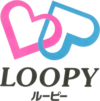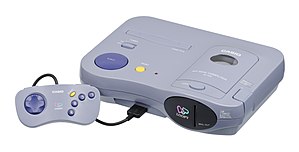

This article needs additional citations for verification. Please help improve this articlebyadding citations to reliable sources. Unsourced material may be challenged and removed.
Find sources: "Casio Loopy" – news · newspapers · books · scholar · JSTOR (December 2018) (Learn how and when to remove this message) |
 | |
 | |
| Also known as | My Seal Computer SV-100 |
|---|---|
| Manufacturer | Casio |
| Type | Home video game console |
| Generation | Fifth |
| Lifespan |
|
| Introductory price | 25,000¥ |
| Media | ROM cartridge |
| CPU | SH7021 32-bit SuperH |
| Memory | 1MB RAM |
| Storage | 2MB ROM |
| Display | NTSC-M composite video out |
| Graphics | 512 colors |
| Sound | 4 channels, 12-bit PCM |
| Controller input | D-pad and mouse |
| Predecessor | PV-1000 |


The Casio Loopy (Japanese: ルーピー, Hepburn: Rūpī), subtitled My Seal Computer SV-100, is a 32-bit home video game console. Released exclusively in Japan in October 1995 with a price of 25,000¥, the marketing for it was completely targeted to female gamers.[1][2][3]
The console is powered by a Hitachi SH7021 SuperH 32-bit RISC CPU running at 16MHz, and had 1MB of RAM and 2MB of ROM.[4][5] It was capable of displaying 512-color graphics and of playing 4 channels of 12-bit PCM audio.[5]
The Loopy has one controller port[1] for use with a standard game controller or with a mouse which was sold separately.
The Loopy includes a built-in thermal color printer that could be used to create stickers from game screenshots. An optional accessory, called Magical Shop (マジカルショップ, Majikaru Shoppu),[5] was a video capture device to obtain images from VCRs and DVD players. Users may add text to these images and make stickers. Including Magical Shop's own built-in software, the Loopy library contained 11 titles.[5]
Developer Kenji Terada worked on I Want a Room in Loopy Town! (ルーピータウンのおへやがほしい!, Rūpī Taun no O-heya ga Hoshii!).[6]
Software development ended in November 1996, and Casio ceased production of the console in December 1998.[1]
Eleven titles were released for the system.[5][7][2]
The games PC Collection and Lupiton's Wonder Palette were both packaged either as stand-alone or bundled with the mouse.
|
| |||||
|---|---|---|---|---|---|
| Types |
| ||||
| Generations |
| ||||
| Fifth generation |
| ||||
|
| |||||||||||||
|---|---|---|---|---|---|---|---|---|---|---|---|---|---|
| Atari |
| ||||||||||||
| Bandai |
| ||||||||||||
| Casio |
| ||||||||||||
| Coleco |
| ||||||||||||
| Commodore |
| ||||||||||||
| Epoch |
| ||||||||||||
| LeapFrog |
| ||||||||||||
| Mattel |
| ||||||||||||
| Microsoft (Xbox) |
| ||||||||||||
| NEC |
| ||||||||||||
| Nintendo |
| ||||||||||||
| Panasonic |
| ||||||||||||
| Philips |
| ||||||||||||
| RCA |
| ||||||||||||
| Sega |
| ||||||||||||
| SNK (Neo Geo) |
| ||||||||||||
| Sony (PlayStation) |
| ||||||||||||
| VTech |
| ||||||||||||
| Others |
| ||||||||||||
|
| ||||||||||||||||||||||||
|---|---|---|---|---|---|---|---|---|---|---|---|---|---|---|---|---|---|---|---|---|---|---|---|---|
| Products |
|
| ||||||||||||||||||||||
| Other |
| |||||||||||||||||||||||
| ||||||||||||||||||||||||
This video game-related article on computer hardware is a stub. You can help Wikipedia by expanding it. |